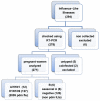Low clinical burden of 2009 pandemic influenza A (H1N1) infection during pregnancy on the island of La Réunion
- PMID: 20531946
- PMCID: PMC2878351
- DOI: 10.1371/journal.pone.0010896
Low clinical burden of 2009 pandemic influenza A (H1N1) infection during pregnancy on the island of La Réunion
Abstract
Background: Pregnant women have been identified as a group at risk, both for respiratory complications than for the admissions to the Intensive Care Unit (ICU) during the 2009 H1N1 influenza pandemic (pdm). The purpose of this prospective register-based cohort-study was to characterize the clinical virulence of the pdm (H1N1/09)v during pregnancy in La Réunion.
Methods/principal findings: Over a twelve-week pdm wave (13 July to 3 October 2009), 294 pregnant women presented with an influenza-like illness (ILI) to one of the three maternity departments of the South Reunion area, Indian Ocean. Out of these, 278 were checked by RT-PCR for influenza viruses (157 positive and 121 negative, of whom, 141 with pdm flu and 132 with ILIs of non pdm origin, 5 untyped). The median body temperature was higher in women experiencing pdm flu than in those with non pdm ILI (38.9 degrees C versus 38.3 degrees C, P<0.0001), without evidence linked to circulating viremia. Oseltamivir was given for 86% of pdm flu cases in a median time inferior than 48 hrs (range 0-7 days). The hospitalization rate for pdm flu was of 60% and not associated with underlying conditions. Six viral pneumonia and fourteen asthma attacks were observed among 84 hospitalized pdm flu cases, of whom, only one led to the ICU for an acute lung injury. No maternal death occurred during the pdm wave. None adverse pregnancy outcome was associated with pdm flu. No congenital birth defect, nor early-onset neonatal influenza infection was attributable to pdm flu exposure.
Conclusions/significance: This report mitigates substantially the presumed severity of pandemic H1N1/09 influenza infection during pregnancy. The reasons for which the clinical burden of H1N1/09 influenza virus may differ worldwide raise questions about a differential local viral-strain effect and public health preparedness, notably in timely access to special care and antiviral treatments.
Conflict of interest statement
Figures



References
-
- Chowel G, Bertozzi SM, Colchero MA, Lopez-Gatell H, Alpuche-Aranda C, et al. Severe Respiratory Disease Concurrent with the Circulation of H1N1 Influenza. N Engl J Med. 2009;361:674–9. - PubMed
-
- Perez-Padilla R, de La Rosa-Zamboni D, Ponce de Leon S, Hernandez M, Quiñones-Falconi F, et al. Pneumonia and Respiratory Failure from Swine-Origin Influenza A (H1N1) in Mexico. N Engl J Med. 2009;361:680–9. - PubMed
-
- Webb SA, Pettilä V, Seppelt I, Bellomo R, et al. The ANZIC Influenza Investigators. Critical Care Services and 2009 H1N1 Influenza in Australia and New Zealand. N Engl J Med. 2009;361:1925–34. - PubMed
-
- Louie JK, Acosta M, Winter K, Jean C, Gavali S, et al. Factors associated with death or hospitalization due to pandemic 2009 influenza A(H1N1) infection in California. JAMA. 2009;302:1896–902. - PubMed
Publication types
MeSH terms
LinkOut - more resources
Full Text Sources
Medical

